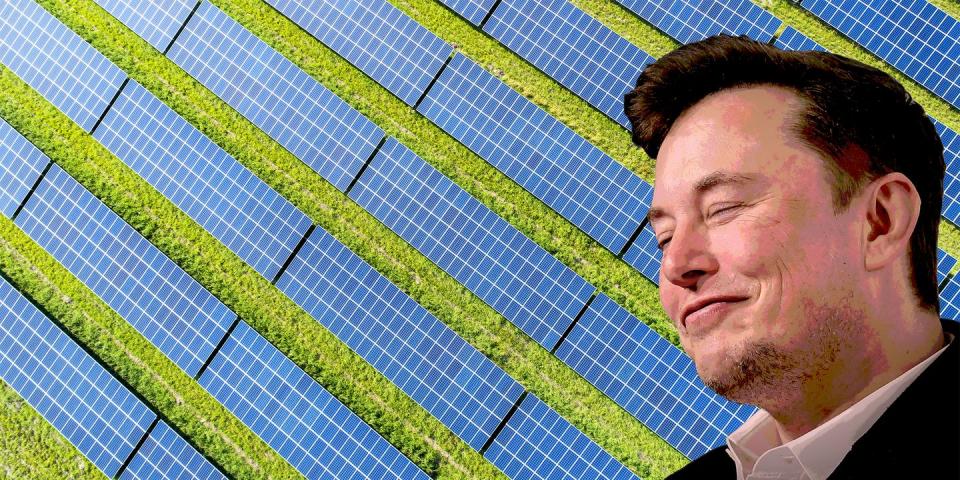Elon Musk's Plan for One Giant Solar Farm Is a Little Insane, but Not Completely Insane

Elon Musk is once again touting his idea to turn 10,000 square miles of U.S. desert into a solar farm that can power the entire country.
The cost of this solar farm is potentially eye-watering, but it may be one of the less expensive of the possible options.
This is one of the more feasible “Elon’s whimsical inventor tweets.”
Elon Musk has revived his idea to power the entire U.S. with one single, giant solar farm. In a recent tweet evidently directed at fellow mega-billionaire Bill Gates, Musk insinuated that his grand solar plan is actually quite simple (hat-tip to Inverse):
He’s def wrong. Solar power is a Gigawatt per square km! All you need is a 100 by 100 mile patch in a deserted corner of Arizona, Texas or Utah (or anywhere) to more than power the entire USA. This analysis goes through calcs https://t.co/fI1I452tm6
— Elon Musk (@elonmusk) December 7, 2019
Musk guesstimates the farm would be 100 miles by 100 miles. His idea isn’t feasible on its own, and is largely considered a gestural idea toward the possibility for new solutions with existing technology.
The United Nations believes the technology to address climate change already exists and that the policies and behaviors required will be cultural and financial. Countries must spend the money to enact solutions and build out robust, full-service mechanisms using pieces of existing technology.
Musk’s idea for a single giant solar grid to support the entire U.S. is what TV food personality Alton Brown would call a unitasker: something limited to one specific use case, and therefore a waste of money. As Inverse points out, a big enough storm or even severely overcast day would knock out the electrical grid, unless Musk plans to include cutting-edge solar storage as part of his national solar farm.
The fan whose reply prompted Musk’s renewal of his solar idea mentioned Gates’s widely shared soundbyte that solar is “cute,” but nuclear is the real way forward. (His actions since have indicated a change of heart.) But nuclear’s public favorability keeps falling, from the “nuclear golden age” in the 1950s to repeated international nuclear disasters to Germany’s love affair and very public breakup with nuclear energy. Where nuclear energy studies have largely stagnated, solar and wind have made giant steps forward, partly by building off of the cooling technologies pioneered by nuclear plants.
Though Musk’s plan still seems wild, solar has come a long way very fast. Fifteen years ago, The West Wing protagonist Josh Lyman crashed an H2 at the dealership where he went to test drive a waitlisted Prius. It’s not a good episode—later, Toby Zeigler referred the press to the “department of whimsy,” help—but Lyman’s punishment was to meet with experts who summarized the state of alternate energy. The experts sniped at each other, and the solar guy explained he’d need what was then a 300 mile by 300 mile area.
Solar guy: “Buying square footage in the desert west won’t be a problem.”
Josh: “What will?”
Wind lady: “Manufacturing that many solar cells.”
Solar guy: [hesitating] “We’d have to pick up the pace some.”
Hydrogen guy: “You might say—since all the solar cells ever made to this point would barely cover ten square kilometers.”
Since then, manufacturing has accelerated wildly. The world is apparently adding 70,000 solar panels per hour. If Musk’s estimated area is right, it shows how much energy density has increased in solar panel technology, too. But outfitting an area that size with Musk’s own Tesla Roof tiles, for example, would still cost nearly $5 trillion dollars—if the government offered the same per-home tax credit to scale. If not, it would cost $6 trillion. That’s the GDP of Japan.
Is that really so much? Nuclear power plants cost between $6 and $9 billion each to build, in 2008 dollars at least. Nuclear accounts for 20 percent of our current power grid, which comes from just 60 plants. To build an additional 240 plants would be about $1.5 trillion. That's much cheaper, but it comes with the vulnerabilities associated with any nuclear reactor. Places that experience meltdowns and other nuclear emergencies—heck, even residents in places deemed "high risk" after 9/11 because of local nuclear plants—might be willing to make the costly trade for solar.
This particular Musk claim is, at least, not the hyperloop. If what stands between us and an energy independent future is one gulp-worthy investment in solar infrastructure, the fact that world governments will likely never do it doesn’t mean it’s a bad idea. In 200 years, we might look back at this solar moment as our own beginning of the unified utopian Earth of the United Federation of Planets.
You Might Also Like
